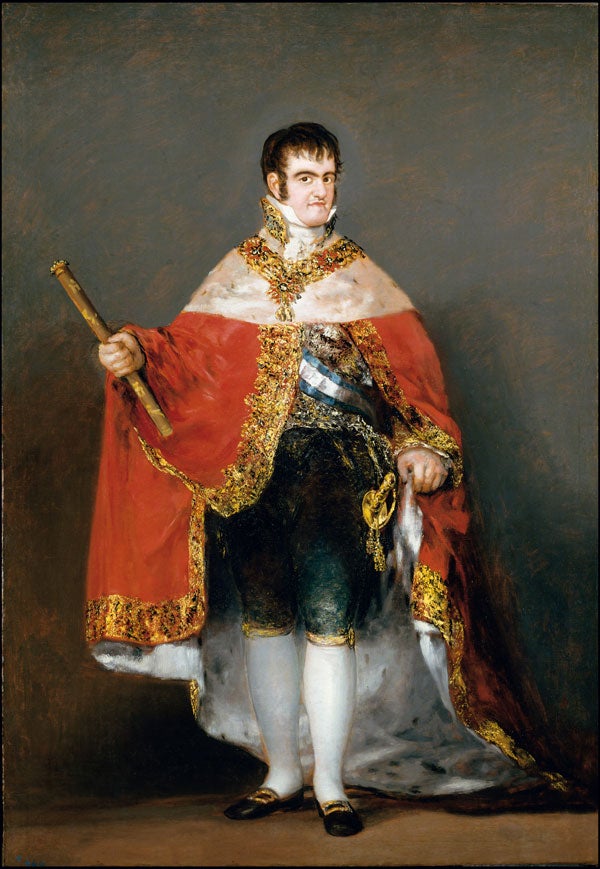Great Works: Ferdinand VII in Royal Robes, 1815 (208 x 142.5 cm), Francisco José de Goya y de Lucientes
Prado, Madrid

There were so many Goyas inhabiting that rather nondescript body. There was the Goya who in his early tapestries could exercise the most exquisite neo-classical restraint. Then, much later on, there was the Goya whose visions were so grotesque and so dark that he seems to prefigure the horror comics of our own day.
The Goya of this particular painting of 1815, a deaf man of almost 70 years of age, had already enjoyed an extraordinarily long and lucrative career as court painter to the Spanish Bourbons. This in itself is quite surprising. Was this man so easily tameable then? No. He never flattered his masters. In fact, he was starkly truth-telling. But what he also did was to behave with the utmost discretion. So practised at it, in fact, that he was never caught out. We can only conclude that his employers were such self-preening, vainglorious fools that they did not even notice.
Yes, of all the great paintings in the Western tradition, this is surely one of the slyest. It does not stoop to flatter in predictable ways. It is not Van Dyke painting up the doomed Stuarts. It does not physically enhance the presence of this tot-like, doll-like monarch. It leaves him looking exactly the height that he must have been when he was painted. It is far from serious in tone. In fact, it is a marvellous visual feast of pantomimic excess, a portrait of a little man who is so ludicrously burdened by the visual trappings of kingship that he might as well be carrying a pregnant donkey across his back.
And yet there is also – and herein lies the exquisite subtlety of it all – enough remaining here to please the man. There is an extraordinary, almost spot-lit glitter about his presence, as if, in his own well-rooted estimation, he is almost god-like. We can see that wherever he goes, he will be surrounded by those who will serve him and flatter him and feed him sweeties in his lukewarm bath, one by one. He has that dead, fish-like sheen to the eyes which suggests that he evidently takes much self-satisfied pleasure in such airy nothings. His mouth is small, and pursed; his chin hangs over his winged collar, heavily, lumpishly. That mouth is aggressively anti-erotic, utterly unkissable. His right arm gestures outward, rather woodenly, as if it vaguely exercising for the sake of the exercise. He grips the staff of office (and, incidentally, he makes that staff look as unalluring and as symbolically insignificant as a baton in a relay race) in his fat-fingered fist, with the utmost gracelessness, as if, in his own opinion (though not ours, and certainly not Goya's), he is not only offering himself as an exquisite painted gift to all those who will have the pleasure to behold his deathless image (and there it hangs still, in the Prado, to be admired by all), but also encompassing the entire world in his gesture. Such is his breadth of view, his breadth of vision, his breadth of influence.
And yet while we can readily acknowledge all this, we know within our heart of hearts that it is all a painted masquerade, and that it is precisely this utter falseness of his sad, trumped-up human presence that Goya is also recording. In fact, you could say – and this is so unusual for a painting of a monarch – that there is in this painting a complete division between the man who lives and breathes and the trappings that adorn his wretched person. Goya has gone hell for leather to make these accoutrements look as wonderful as possible. We see them as any human would see them who is impressed by royalty and its fripperies – slightly blurrily, as if our eyes are dazzled by the sumptuousness of it all, as if our spectacles are a little fogged by overmuch emotion. But when it comes to the man himself, the situation is entirely otherwise. The human element here is slow, oafish, and utterly ridiculous in its green breeches. What is this turnip-top doing in such clothes? Do they really belong to him at all? Why doesn't he step down – before he falls down – and make way for a real king?
ABOUT THE ARTIST
Francisco José de Goya y Lucientes (1746-1828), the son of a tradesman and of a mother who believed herself to belong to the minor nobility, was born in a small house in the nondescript Aragonese village of Fuendetodos. His output was vast and various. About seven hundred paintings survive by him, together with countless works on paper. The range of his work was quite astonishing. He could paint exquisite portraits of the nobility, and scenes of madness and irrationality – barbaric dreams out of some folkloric nightmare. He often castigated the follies of women. A celebrated cycle of etchings, 'Disasters of War', exposes the horrors of the Peninsular War. In spite of his unruly imagination, he managed to remain the well-paid court painter to the Bourbons for decades, and painted their not so august presences with a brilliant, pitiless, near-farcical rigour that they scarcely seem to have noticed. To see these paintings in the Prado today justifies any visit to Madrid.
Join our commenting forum
Join thought-provoking conversations, follow other Independent readers and see their replies
Comments
Bookmark popover
Removed from bookmarks